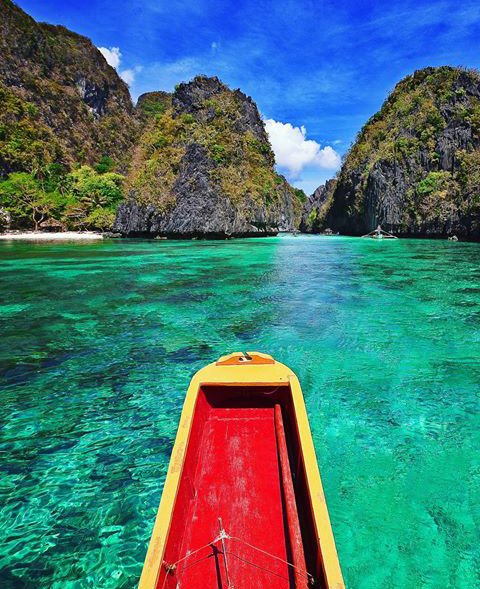
This is from the middle of the sea in El Nido Palawan where in you can see the different kind of rock island, the island can accommodate many tourists. You can rent tent or bring your own tent there. As you can see the water is so crystal clear blue.El Nido has been inhabited by humans as early 2680 BC, or even up to 22,000 years ago, this was confirmed by the fossils and burial sites, dating back to the Late Neolithic Age, that can be found in many caves and excavation sites surrounding the municipality, particularly the Ille Cave in New Ibajay. Chinese traders had been regularly visiting the area of El Nido for its edible birds' nests during the Song Dynasty (960-1279). In fact, El Nido is specifically mentioned in Chinese records as far back 1225. Chau Ju-Kua, a member of the Chinese Royal Family, Trade Commissioner and Superintendent of Customs of the Port of Chuan How wrote about the island, Pa-Lao-Yu or Land of Beautiful Harbors in his book Chu Fan Chi. The town traces its roots from a small Tagbanwa village called Talindak. Some time in the 16th century, waves of migrants from Cuyo Islands came here to settle. In the 1800s, the Spaniards arrived, and they moved to the part where the present-day Poblacion and Mabini are located. The first Spanish families were the Canovas, Vazquez, Rios and Rey. In 1890, the Spaniards renamed it as Bacuit. At the time, the center of the town was Cabigsing, then known as Inventario. Chinese families moved into the area about the same period, first settling in Langeblangeban. The first Chinese settlers were named Lim, Chin, Liao, Edsan, Ambao, Que-Ke, Lim Piao, Yu His, Pe Phan and Pe Khen.
During the Spanish colonization of the Philippines, the town was under the jurisdiction of the Municipality of Taytay, which was the capital of the former Province of Calamianes from 1818, and the Province of Castilla, the area of what is now known as northern Palawan, from 1858. It remained part of Taytay until 1916 when it formally became an independent municipality, the new municipality was then known as Bacuit. On June 17, 1954, Republic Act No. 1140 was approved changing the name of the town from Bacuit to its present name El Nido after the edible nests of swiftlets (collocalia fuciphaga), found in the crevices of its limestone cliffs. These nests, nido in Spanish, the main ingredient for the gourmet nido soup, are being sold at approximately US$ 3,000 per kilogram. El Nido. officially the Municipality of El Nido is a first Class Municipality in the province of Palawan, Philippines. According to the 2015 censue it has a population of 41,606 people. It is about 420 kilometers(260 mi) souht west of manila and about 238 kilometers(148 mi) north east of Puerto Prinsesa, Palawan's capital. A managed resource protected area, it is known for its white sand beaches, coral reefs, limestones cliffs and as a gateway to the bacuit archipelago.El Nido is currently ranked number four in Conde Nast Traveler's list of 20 Most Beautiful Beaches in the World. CNNGo has called it the Best Beach and Island destination in the Philippines for its extraordinary natural splendor and ecosystem, situated in Bacuit Bay, El Nido, covering a land area of 465.1 square kilometres (179.6 sq mi) in the northernmost tip of mainland Palawan, is bordered by the Linapacan Strait in the north, the Sulu Sea in the east, and the South China Sea in the west. It is composed of 45 islands and islets, each has its own unique geological formations. The highest peak is at Cadlao Island, towering up to 640 metres (2,100 ft)above sea level.
Together with Sulu Archipelago, Sabah, and South China Sea, El Nido, being part of Palawan, is located in the tectonically active and seismically active Sunda Plate, a plate that is entirely separate from the Philippine Mobile Belt to which the rest of the Philippines belongs. The Permian to Paleogene rocks and limestone cliffs of El Nido are similar to those that can be found in Ha Long Bay in Vietnam, Guilin in China, as well as Krabi in Thailand, all of which are part of the Sunda Plate.
follow upvote resteem @vaness
Hi! I am a robot. I just upvoted you! I found similar content that readers might be interested in:
https://en.wikipedia.org/wiki/El_Nido,_Palawan
Downvoting a post can decrease pending rewards and make it less visible. Common reasons:
Submit